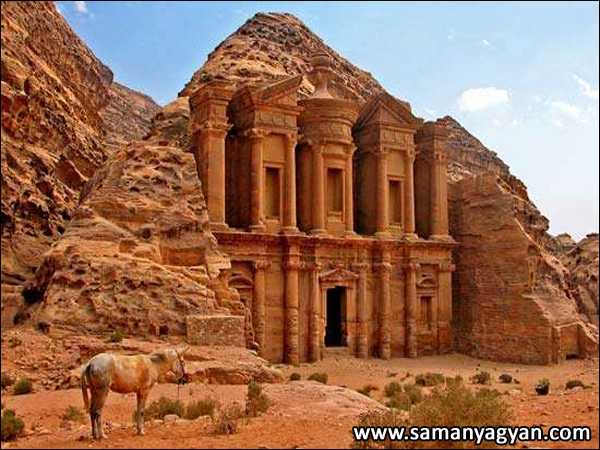Petra Jordan Quick Facts
| Place | Petra, Maan Governorate (Jordan) |
| Built in | Around 5th century BC |
| Built by | Nabataean Empire |
| Architectural style | Mixed form of Mesopotamian and Hellenistic |
Petra Jordan Overview
Petra, located in the Ma'an Governorate province of Jordan, is a treasure trove of ancient world history. This city is an indicator of an advanced human civilization, which shows that even in ancient times, people had advanced technology and knowledge. It is an ancient and interesting city nestled within the rugged mountains of Jabal al-Madbah, which is currently attracting tourists from all over the world for its majestic and ancient site.
Petra Jordan History
Many powerful empires flourished in ancient world history, one of which was the Nabataean Empire, which ruled the city of Petra for many years. Around 6th century BC Petra had developed into an influential economic and political capital by the Nabataean Empire in AD.
Petra was the most developed and economically strong country in the ancient world, far better than any empire. The Roman Empire began to expand in about 106 AD, after which the Roman Empire captured Petra in about 106 AD and the Romans continued to expand the city.
An important center for trade and commerce, Petra continued to grow until a devastating earthquake destroyed buildings and Petra was conquered by the Muslims in the 6th century AD, but it remained on it for a long time.When the Muslim Sultan Saladin of the Middle East conquered Petra in 1189 AD, the Christians abandoned that place. After the formation of Trans-Jordan, the first real excavation of this place was done in 1929 AD. Since 1989, this place has become the biggest tourist attraction of Jordan.
Petra Jordan Interesting Facts
- It is believed that the city was founded around 312 BC. Which is one of the oldest cities in the world.
- It is said that this city dates back to the first century BC. It was inhabited by about 20,000 to 30,000 people between the 1st century AD and was used as an important trading city.
- The civilization of this city is one of the largest civilizations in the world, covering an area of about 264 sq. km. It is covered over an area of about 810 meters above sea level.
- The city is believed to have been the center of a severe earthquake between the 1st century BC and the 8th century AD, which was greatly damaged by an earthquake in the year 363 AD, destroying half of the city due to this earthquake. went.
- In the year 1812 AD, a Swiss explorer “Johann Ludwig Burckhardt” discovered this historic city and addressed it as the 'Lost City' as it was an unknown metropolis for almost 5 centuries.
- David Roberts, a Scottish painter, visited the ancient city in 1893 and returned to England with photographs and stories of Petra's encounters with the local tribes.
- For the history, advanced civilization, and artwork of this ancient city, it was declared a World Heritage Site by UNESCO in the year 1985.
- This amazing city was included in the list of the New Seven Wonders of the World in the year 2007 due to its structure and charm.
- In 2016, some archaeologists using satellite imagery discovered a large and unknown massive structure buried under the sands of Petra.
- An advanced drainage system was developed in this wonderful ancient city, which was destroyed due to a terrible earthquake in about 363 AD.
- The name Petra comes from the Greek word 'Petros' which means "Rock". It is also known as Al-Batra in Arabic.
- This famous historical city was ruled for many years by the skilled rulers of the Nabataean Empire, who were skilled water collectors.
- The city is also known as the "Rose City" because of the color of its rocks, which appear to be reddish-pink at sunrise and sunset.

